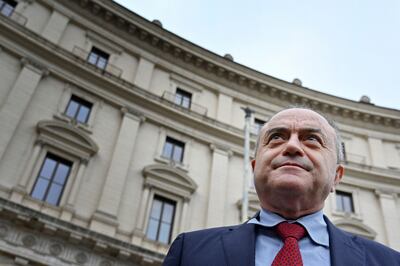A people-smuggling gang responsible for trafficking migrants across Europe has been dismantled, Italian police said on Wednesday.
They arrested 29 suspected traffickers accused of smuggling migrants from the Middle East and Africa across Italy and into northern Europe.
The four-year investigation provided law enforcement with groundbreaking understanding of how smuggling gangs work together, Catanzaro area chief prosecutor Nicola Gratteri said.
“For the first time, we succeeded in demonstrating all the passages, all the steps of the migrant, depending on the passenger's origin and desired destination,” Mr Gratteri added.
“For example, departing from Syria and going to Oslo, or wherever they wanted to go.”
More than 200 police carried out raids across Italy, including in Milan and Turin, after an international investigation that included co-operation from police in Turkey, Greece, Belgium, Germany, Sweden, Britain and Morocco.
Many of the migrants transported by the gang arrived from Turkey or Greece, often on well-outfitted sailboats that elude detection by police or military patrols, police said.
Migrants would pay up to €15,000 ($16,500) each for the sea leg of the voyage, although the going rate appeared to be €10,000.
After landing in southern Italy, either in the Calabria or Puglia regions, passengers would take lorries, trains or taxis to the country’s northern borders and from there would head for destinations across northern Europe.
Key transit points included Ventimiglia, an Italian city near the border with France, and Trieste, in eastern Italy near Slovenia.
From the moment the migrants set foot in Italy, they were in the hands of the gang.
“In effect, a real and true system of illegal welcome, organised both abroad and in various Italian cities, that included food and lodging in the various stops, was created, and to which the migrants entrusted themselves completely,” said Francesco Messina, a top Italian police official.
All that came at an extra price. Migrants were charged up to €600 euros to reach northern cities such as Milan.

In Calabria, Mr Gratteri described the investigation as groundbreaking in terms of understanding how a series of smuggling gangs work together.
He said they had tracked the routes and revenue, and how they profited off their victims’ misery and desperation.
Mr Messina said that besides smuggler cells in Greece and in Turkey, the investigation found seven more operating in Italy.
One cell, based in Trieste, also served as the money-processing hub, investigators said. The smugglers transferred money abroad weekly in sums they hoped would be low enough to avoid triggering suspicion.
Another key point in the operations was Thessaloniki, Greece, from where migrants were moved to Athens and Patras. Others directly set sail for Italy's southern coastline from Izmir, in Turkey, Italian police said.
The smugglers exploited a sea route on the Eastern Mediterranean and used sailboats, which are less likely to be suspected of being migrant vessels than the frequently used overcrowded rubber dinghies or decrepit wooden fishing boats, according to Italian authorities.





